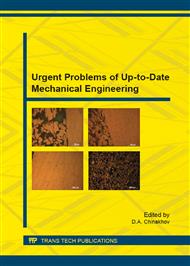[1]
Adamyan V.G., Surface finish during processing with two blade- and straight-edge cutters , J. NAS and SEUA. 3 (2002) 349-353.
Google Scholar
[2]
Bobrov V.F. Effect of cutting edge angle on metal cutting, Mashgiz, 1962, 152.
Google Scholar
[3]
Bobrov V.F., Metal cutting with Auto Rolling cutters, Mechanical Engineering, 1972, 110.
Google Scholar
[4]
Galojan G.P., Theoretical Foundations of diagonal turning, J. Candidate tehn. Sciences, Leninakan, 1986, 157.
Google Scholar
[5]
Klimenko S.A., Hard shaving, turning, J. Superhard Materials. 1 (2009) 58-74.
Google Scholar
[6]
Konovalov E.G. Progressive process charts of rotary metal cutting, Minsk, Science and Technology, - 1972 , 272.
Google Scholar
[7]
Manohin A.S. Surface irregularities processed with oblique tools, J. Superhard materials. 2 (2009) 61-70.
Google Scholar
[8]
Petrushin S.I. Analysis of geometry of oblique grinding with straight edge cutters, J. Processing of metals. Technology. Equipment. Tools. 2 (2013) 8-14.
Google Scholar
[9]
Podgorkov V.V., Finishing with one-edge cutters, J. STIN. 1 (1974) 30-31.
Google Scholar
[10]
Rivkin G.M., Finishing with cutters with movable cutting plate, J. STIN. 4 (1952) 20-22.
Google Scholar
[11]
Filippov A.V., 3D modeling of oblique lathing, J. Innovations in Mechanical Engineering. (2012) 178-182.
Google Scholar
[12]
Filippov A.V., Modeling of geometric parameters of oblique lathing with front face radius cutter, J. Modern Problems of Mechanical Engineering. (2013) 361-364.
Google Scholar
[13]
Filippov A.V. Cross section of turning layer at oblique lathing with straight edge cutter, J. STIN. 4 (2014) 21-25.
Google Scholar
[14]
Filippov A.V. Digital correlation interferometry of chip formation in metal cutting, J. Herald of MSTU. N.E. Bauman. Ser. Engineering,. 2 (2014) 100-113.
Google Scholar
[15]
Filippov A.V. , On the effect of cutting tools geometry on formation of plastic deformation zone in materials, J. Baikal materials science forum: All-Russian Scientific. conf. 2 vol. - Ulan-Ude: BSC SB RAS. 1 (2012) 157-159.
Google Scholar
[16]
Yascheritsyn P.I. Rotary metal cutting, Science and Technology, 1987, 229 p.
Google Scholar
[17]
Grzesik, W., A real picture of plastic deformation concentrated in the chip produced by continuous straight-edged oblique cutting, J. Mach. Tools Manuf. 3 (1991) 329-344.
DOI: 10.1016/0890-6955(91)90079-i
Google Scholar
[18]
FilippovA.V., Constructing model of oblique cutting edge, J. Applied Mechanics and Materials. 379 (2013) 139-144.
Google Scholar


